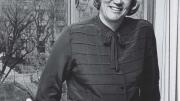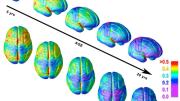Any Massachusetts Hall presidential transition—like the current one from Drew Gilpin Faust to Lawrence S. Bacow—naturally brings to mind questions about University leadership: who is best equipped to chart Harvard’s course, in the prevailing circumstances, to the age that is waiting before? So the arrival of An Academic Life is fortuitous and timely. The memoir of Hanna Holborn Gray extends from her youth and development as a scholar of Renaissance intellectual history trained at Harvard (Ph.D. ’57), through her seriatim roles as dean of the College of Arts and Sciences at Northwestern, Yale Corporation fellow/provost/interim president, and University of Chicago president.
Those who have observed segments, or all, of Gray’s leaderly career from afar will recognize her simultaneously plain-spoken and formidable manner in her title. (Further insight comes from the austere citation accompanying her 1995 Harvard honorary degree: “Powerful in judgment, humane in values, profound in learning, incisive in wit. She has lifted American education ever higher.”) She has chosen to construct a record that focuses almost exclusively on her life in and of academe—and to reveal little about her adult, inner life otherwise, apart from a couple of affectionate sections about her late husband, Charles Gray ’49, JF ’56, Ph.D. ’56, himself a scholar of legal history.
One way she lifted higher education ever higher was by forcing its eyes and doors open—the latter, literally. In an important respect, An Academic Life is the tale of an outsider, told after she has been admitted to formerly forbidden precincts. Women (and men) in the academy now would do well to remember the conditions under which Gray and her few fellow peers labored. To focus only on the Cambridge years of her memoir, the Radcliffe where she enrolled as a graduate student in 1951 “while separate…was not equal.” Indeed, “It was sometimes said that Radcliffe was coeducational and Harvard was not, or, as President [James Bryant] Conant remarked, that Harvard was ‘coeducational in practice but not in theory.’” The same—great, in other respects—Conant confessed that “when it comes to the education of the fairer sex, I throw up my hands in complete despair and consternation…it is very much like asking a Christian Scientist to speak at the fiftieth anniversary of a medical school.”
The Faculty of Arts and Sciences had one female full professor in 1951, Helen Maud Cam. (Her portrait, hung in University Hall’s Faculty Room in 1995, was precedent-setting in the same way; see “First Swallow of Summer,” May-June 1995, page 62.) Cam became the first woman to attend Morning Prayers, instituted in 1638, Gray writes, “simply by virtue of going and sitting down in the chapel each day.” One conceives of her, and Gray, as daunting—every bit as much as the “very lively group” of political scientists, including Henry Kissinger, Samuel Huntington, and Zbigniew Brzezinski, to whom Gray was introduced by her brother, Fred, concurrently studying at Harvard’s school of public administration.
As the first female tutor in history and literature, Gray found that the Signet Society “was reluctantly forced to let me attend the obligatory tutors’ lunches.…There the waiters, if not the members, made me feel at home.” Then again, as an assistant professor of history attending departmental lunches, “Women were not allowed through the front door of the Faculty Club, only through a side door (and not, of course, in the main dining room).” Perhaps channeling her inner Cam, Gray “took to going through the front door” and “the prohibition gradually faded away.” She first entered Lamont Library (coeducated in 1967) as a member of the Harvard Corporation.
Was the construction, or at least reinforcement, of a carapace an adaptation to her times? What was lost when women were relegated to the side door—and gained when they pried open the front? And who remains “outside” today?
The second sterling takeaway from Gray’s “academic life” is a crystalline understanding of the academy’s essence and role. For her, that likely arose from primal memories and family accounts of her father’s crushing experience of the Nazi destruction of the Hochschule für Politik, in Berlin, where he was appointed Carnegie professor of international relations and history in 1931. A private, independent institution, it was politically neutral, diverse in views and party affiliations, and committed to education for citizenship, training for public service, and scholarly research. Within two years, as Hitler ascended, “Students were to play, and were asked by the party to play, a central role in the ‘purification’ of universities and in the public displays of book burning in 1933.” After that April, he—and half the entire Hochschule faculty—emigrated in the wave that brought to the United States, particularly, a formidable generation of German scholars.
It is unsurprising that, embedded in American universities, those emigrant intellectuals and their academic children recoiled from the (leftist) student uprisings in the late 1960s. What is revealing in her narrative is Gray’s telling of the University of Chicago’s trauma—seemingly decisive in the shaping of her own views. The “nonreappointment” of a female assistant professor prompted a sit-in, complete with a 16-day takeover of the administration building by as many as 400 students, in the winter of the fraught year of 1969. The president, Edward Levi, kept the police off campus, and waited the protest out. Crucially, in Gray’s telling:
He made the crisis an occasion to offer a kind of running seminar on the questions of what a university was for, why it mattered, and why the activists’ views, demands, and actions threatened its integrity and most important purposes by attempting to make the university an instrument of social and political change, confining the freedom of its members, and promoting an anti-intellectual spirit where the free life of the intellect should be paramount. His eloquent speeches and communications constitute some of the best statements on the fundamental nature and role of universities that I know.
(Coincidentally, Gray chaired a committee to review the contested nonreappointment that ignited the protest, and found that there had been no irregularities. As for the protestors, 81 were suspended and 42 expelled: “Amnesty was not the rule at the University of Chicago as it more commonly was elsewhere.”)
On the final page of her memoir, Gray underscores the message. “The belief that universities should be, above all, the homes of searching and critical intellectual vigor and thought needs recurrent renewal and reaffirmation,” she writes. “Universities have always been vulnerable to outside influence and to the threat of control and manipulation, and they have been vulnerable, too, to conformities imposed from within.” That, in the abstract, is the essence of the research-university leader’s core responsibility today. And lest anyone forget the stakes:
My parents and their fellow refugees survived the most extreme assault ever launched against universities from a totalitarian regime bent on reconfiguring…universities, and the disciplines they taught and studied, into its own ideological image, distorting their purposes to serve its own ideological ends. The academic refugees had witnessed also the passivity and widespread complicity of the professoriate from which they had been dismissed. These émigrés brought with them to America a faith in the prospects of academic freedom and its goals. They were hopeful about the potential of the still-youthful universities of their new country to be freer, more democratic, and more open than the rigid and conservative institutions they had known at home even in better days, and they found those hopes in many ways fulfilled.
Thus Hanna Gray was annealed into a champion of the academy. But it would be wrong to miss a third theme running through her narrated life, harking back to that citation about her “incisive wit.” She displays throughout the book exactly the kind of intellectual, pointed humor that is a reminder of the humanity within, indeed at the base of, any successful leader—in this case, in the quirky community of scholars.
At her own expense, she recalls a Bryn Mawr professor thus: “Proud of a paper I had written, I looked eagerly for her comments and found only this: ‘I have checked all your footnotes and found them accurate.’ Crushed, I consulted another professor about what this indicated and was told it was actually a compliment.”
Or this, from Charles Gray’s encounters at MIT, his first professorial home: “After they met in the hall one day, and after some conversation, Mr. [Norbert] Wiener asked Charles, ‘What direction was I coming from when we met?’ Charles pointed out the way. ‘Ah,’ said Mr. Wiener, ‘then I’ve had lunch.’”
Or, from her own Hist and Lit experience, an insight into the relatively callow College denizens of the day, some of whom “actually managed to do almost nothing”: “The orals often provided entertaining moments of student chutzpah. I remember one elegant young man who, when asked his view of the impact of social Darwinism, responded that it was like the vermouth in a very dry martini.”
Or, on the other hand, at the most rarefied level of scholarly attainment: When French medievalist Charles Taylor presented his completed dissertation to Charles Homer Haskins “at the great man’s Widener office on Christmas Eve, Haskins kindly said to him, ‘Very good, Taylor. Why don’t you take tomorrow off?’”
Rewards like these aside, connoisseurs of Harvard gossip will be disappointed by Gray’s discretion in concluding her life essentially at the end of her Chicago presidency, in 1993. That decision necessarily keeps veiled her Corporation service, from 1997 through 2005; she earlier served as an Overseer from 1988 to 1994. (Her reportedly central role in selecting Lawrence H. Summers as president, in 2001, thus remains to be excavated decades hence, given the length of time the governing boards’ records are sealed.)
Nor will readers learn how this intellectual historian came to chair the board of trustees of both the Andrew W. Mellon Foundation, the nation’s leading source of philanthropic support for humanities scholarship, and the Howard Hughes Medical Institute, ditto for biomedical research. That in itself indicates what kind of a leader she became during the course of an academic life—in turn a reflection of the toughness, clarity of vision, and inner humanity that university leadership at its best requires.









